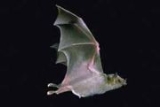
Greater Long-nosed Bat
Encyclopedia
The Greater Long-nosed Bat or Mexican Long-nosed Bat (Leptonycteris nivalis) is a species of bat
in the family Phyllostomidae. It is found in Mexico
, the United States
, and in Guatemala
. Its natural habitat
is temperate forest
s. It is threatened by habitat loss. This species of bat is the pollinator
of the blue agave
plant, the source of Tequila
.
Mexican long-nosed bats synchronize their arrival in Texas with the summer blooming cycle of agave plants on which they rely for pollen and nectar. In Mexico, they also eat the nectar, pollen, and fruit of giant columnar cacti. Like hummingbirds, they hover in front of plants and insert their long noses and tongues deep into the flowers to sip nectar.
In Texas, these bats occur in agave and desert-scrub woodlands at elevations of 4,900 to 7,500 feet. They are seldom found far from the agaves and cacti upon which they depend. These bats are found north of the US border only from June to August. They roost in caves, abandoned mines, and cliff-face cavities in groups ranging from a few to several thousand. Many appear to make relatively long seasonal migrations, remaining active in warm climates year-round. These bats are seldom seen except at night at hummingbird feeders.
Bat
Bats are mammals of the order Chiroptera "hand" and pteron "wing") whose forelimbs form webbed wings, making them the only mammals naturally capable of true and sustained flight. By contrast, other mammals said to fly, such as flying squirrels, gliding possums, and colugos, glide rather than fly,...
in the family Phyllostomidae. It is found in Mexico
Mexico
The United Mexican States , commonly known as Mexico , is a federal constitutional republic in North America. It is bordered on the north by the United States; on the south and west by the Pacific Ocean; on the southeast by Guatemala, Belize, and the Caribbean Sea; and on the east by the Gulf of...
, the United States
United States
The United States of America is a federal constitutional republic comprising fifty states and a federal district...
, and in Guatemala
Guatemala
Guatemala is a country in Central America bordered by Mexico to the north and west, the Pacific Ocean to the southwest, Belize to the northeast, the Caribbean to the east, and Honduras and El Salvador to the southeast...
. Its natural habitat
Habitat
* Habitat , a place where a species lives and grows*Human habitat, a place where humans live, work or play** Space habitat, a space station intended as a permanent settlement...
is temperate forest
Forest
A forest, also referred to as a wood or the woods, is an area with a high density of trees. As with cities, depending where you are in the world, what is considered a forest may vary significantly in size and have various classification according to how and what of the forest is composed...
s. It is threatened by habitat loss. This species of bat is the pollinator
Pollinator
A pollinator is the biotic agent that moves pollen from the male anthers of a flower to the female stigma of a flower to accomplish fertilization or syngamy of the female gamete in the ovule of the flower by the male gamete from the pollen grain...
of the blue agave
Tequila agave
Agave tequilana, commonly called blue agave , tequila agave, mezcal or maguey is an agave plant that is an important economic product of Jalisco, Mexico, due to its role as the base ingredient of tequila, a popular distilled spirit...
plant, the source of Tequila
Tequila
Tequila is a spirit made from the blue agave plant, primarily in the area surrounding the city of Tequila, northwest of Guadalajara, and in the highlands of the western Mexican state of Jalisco....
.
Mexican long-nosed bats synchronize their arrival in Texas with the summer blooming cycle of agave plants on which they rely for pollen and nectar. In Mexico, they also eat the nectar, pollen, and fruit of giant columnar cacti. Like hummingbirds, they hover in front of plants and insert their long noses and tongues deep into the flowers to sip nectar.
In Texas, these bats occur in agave and desert-scrub woodlands at elevations of 4,900 to 7,500 feet. They are seldom found far from the agaves and cacti upon which they depend. These bats are found north of the US border only from June to August. They roost in caves, abandoned mines, and cliff-face cavities in groups ranging from a few to several thousand. Many appear to make relatively long seasonal migrations, remaining active in warm climates year-round. These bats are seldom seen except at night at hummingbird feeders.

